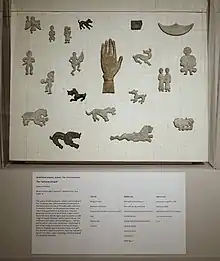Velestino
Velestino (Greek: Βελεστίνο; Aromanian: Velescir) is a town in the Magnesia regional unit, Thessaly, Greece. It is the seat of the municipality Rigas Feraios.
Velestino
Βελεστίνο Velescir | |
|---|---|
 Velestino | |
| Coordinates: 39°22.9′N 22°44.7′E | |
| Country | Greece |
| Administrative region | Thessaly |
| Regional unit | Magnesia |
| Municipality | Rigas Feraios |
| Municipal unit | Feres |
| Elevation | 120 m (390 ft) |
| Community | |
| • Population | 3,403 (2011) |
| Time zone | UTC+2 (EET) |
| • Summer (DST) | UTC+3 (EEST) |
| Postal code | 37 500 |
| Area code(s) | 24250 |
Location
It is situated at 120 metres (390 ft) elevation[2] on a hillside, at the southeastern end of the Thessalian Plain. It is 17 km (11 mi) west of Volos and 40 km southeast of Larissa. Velestino has a train station on the local line from Larissa to Volos.[3] The Motorway 1 (Athens - Larissa - Thessaloniki) passes east of the town. The Greek writer and revolutionary Rigas Feraios was born in Velestino in 1757.[4]
History

Velestino is built on the site of ancient Pherae.[5] The ancient settlement is still attested in early Byzantine times, but was apparently abandoned following the Slavic invasions of the 7th century.[6]
The current settlement appears with its current name—probably of Slavic origin[7]—for the first time in 1208, in a letter by Pope Innocent III mentioning its Frankish ruler, Berthold of Katzenelnbogen.[6] In c. 1213 it was part of the jurisdiction of the Latin bishop of Gardiki, Bartholomew (Cardicensis episcopus et Valestinensis).[6] At about the same time, it became a Greek Orthodox episcopal see as well, being attested thereafter in episcopal lists and acts of the Patriarchate of Constantinople.[6] In 1259 an imperial estate (kouratoria) is attested in the area, as part of the province (thema) of Halmyros; by the 1280s, Velestino itself is listed as a separate thema.[6] Very few traces remain of the medieval town today.[6]
Under the Ottoman Empire, Velestino was called Velestin and was the seat of a kaza within the Sanjak of Tirhala.
With the rest of Thessaly, Velestino was ceded to Greece in 1881 by the Convention of Constantinople.
The Battle of Velestino was fought here during the Greco-Turkish War of 1897.
Velestino is a village partly populated by people of Aromanian heritage. Reportedly, as of 1911, Velestino was predominantly Aromanian.[8]
References
- "Απογραφή Πληθυσμού - Κατοικιών 2011. ΜΟΝΙΜΟΣ Πληθυσμός" (in Greek). Hellenic Statistical Authority.
- GTP - Velestino
- "TrainOSE - 2012 schedules" (PDF). Archived from the original (PDF) on 2012-05-11. Retrieved 2012-05-29.
- Keridis, Dimitris (2009). Historical Dictionary of Modern Greece. Scarecrow Press. p. 67. ISBN 9780810859982.
- Smith, William (1854). "Pherae (Φέραι) (1)". Dictionary of Greek and Roman Geography. London: Walton and Maber.
- Koder, Johannes; Hild, Friedrich (1976). Tabula Imperii Byzantini, Band 1: Hellas und Thessalia (in German). Vienna: Verlag der Österreichischen Akademie der Wissenschaften. p. 133. ISBN 978-3-7001-0182-6.
- Vasmer, Max (1941). Die Slaven in Griechenland (in German). Berlin: Verlag der Akademie der Wissenschaften. p. 108.
- Wace, A. J. B.; Thompson, M. S. (1911). "The distribution of early civilization in Northern Greece" (PDF). The Geographical Journal. 37 (6): 631–636. doi:10.2307/1778256. JSTOR 1778256.